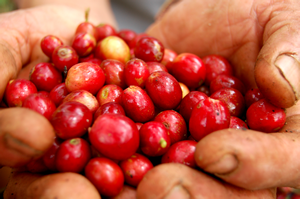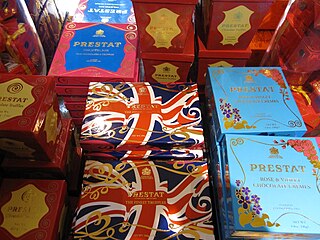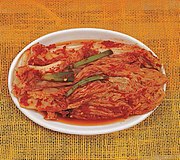
The cocoa bean or simply cocoa, which is also called the cacao bean or cacao, is the dried and fully fermented seed of Theobroma cacao, from which cocoa solids and cocoa butter can be extracted. Cocoa beans are the basis of chocolate, and Mesoamerican foods including tejate, a pre-Hispanic drink that also includes maize.

A cupcake is a small cake designed to serve one person, which may be baked in a small thin paper or aluminum cup. As with larger cakes, icing and other cake decorations such as fruit and candy may be applied.

Central Market is an American gourmet grocery store chain owned by H-E-B Grocery Company based in San Antonio, Texas. Most locations also have a full-service kitchen, offer cooking and wine classes in their culinary school, and offer catering services. The chain has ten locations, all in Texas. Central Market was named "Outstanding Specialty Food Retailer" by Specialty Food Magazine and the National Association for Specialty Food Trade.

Fortnum & Mason is an upmarket department store in Piccadilly, London, with additional stores at St Pancras railway station and Heathrow Airport in London, as well as various stockists worldwide. Its headquarters are located at 181 Piccadilly, where it was established in 1707 by William Fortnum and Hugh Mason. Today, it is privately owned by Wittington Investments Limited.

The Food Emporium is a chain of grocery stores in New York and New Jersey. The supermarket banner was created by Shopwell Inc., whose roots can be traced to Daitch Crystal Dairies. Shopwell Inc. was acquired by The Great Atlantic & Pacific Tea Company (A&P) in 1986 and at the time, the company operated the upscale, gourmet banner stores in New York City, Westchester County, NY, Fort Lee, NJ and Fairfield County, Connecticut. The Food Emporium grew throughout the 1990s, converting many of its New York-area A&P stores to The Food Emporium and expanding the chain to New Jersey. The 2000s brought new, stronger competition to the New York area and the chain shrank, receding mostly to Manhattan. At the time of A&P's liquidation in 2015, The Food Emporium had 11 stores. The banner was acquired from bankrupt A&P in late 2015 by Key Food Stores Co-op, Inc., which currently operates seven of The Food Emporium stores.
Joseph Schmidt Confections was a San Francisco-based chocolatier, which created gourmet confections with imported Belgian chocolate. The line of confections included truffles of various sizes, slicks, and mosaics. Joseph Schmidt confections ceased operations in 2009.
Dan's Chocolates is a Burlington, Vermont chocolate maker.

The production of foie gras involves the controversial force-feeding of birds with more food than they would eat in the wild, and more than they would voluntarily eat domestically. The feed, usually corn boiled with fat, deposits large amounts of fat in the liver, thereby producing the fatty consistency sought by some gastronomes.

The Gourmet Ghetto is a colloquial name for the business district of the North Berkeley neighborhood in the city of Berkeley, California, known as the birthplace of California cuisine. Other developments that can be traced to this neighborhood include specialty coffee, the farm-to-table and local food movements, the U.S. introduction of chocolate truffles and baguettes, the popularization of the premium restaurant designed around an open kitchen, and the California pizza made with local produce. The business district, also known as Gourmet Gulch, is sometimes more formally referred to as "North Shattuck." After coalescing in the mid-1970s as a culinary destination, the neighborhood received its "Gourmet Ghetto" nickname in the late 1970s from writer Alice Kahn. Early, founding influences were Peet's Coffee, Chez Panisse and the Cheese Board Collective. Alice Medrich began her chain of Cocolat chocolate stores there.
Alice Medrich is a businesswoman, baker and cookbook author with a particular interest in chocolate. She founded the Cocolat chain of chocolate stores, has authored numerous cookbooks, and is referred to as the First Lady of Chocolate.

The third wave of coffee is a movement to produce high-quality coffee. It considers coffee an artisanal food, like wine, rather than a commodity. This involves improvements at all stages of production, from improving coffee plant growing, harvesting, and processing, to stronger relationships between coffee growers, traders, and roasters, to higher quality and fresh roasting, at times called "microroasting", to skilled brewing.

Prestat Ltd is one of London's oldest chocolate shops. It has been awarded two Royal Warrants: from Her Majesty The Queen and Her Late Majesty Queen Elizabeth The Queen Mother.

Dorothy Lane Market is a chain of gourmet grocery stores based and located in the Dayton, Ohio region. In 2001 and 2007, Dorothy Lane Market was named one of only six Outstanding Retailers by the National Association for the Specialty Food Trade (NASFT) at the International Fancy Food Show in New York City. Annual company revenue is $80,000,000 and the company has just over 800 employees. A culinary school is also located in the Dorothy Lane Market at the Centerville location.

D’Artagnan (D'Artagnan, Inc. also known as D'Artagnan Foods) is a food seller and manufacturer of beef, pork, lamb, veal, pâtés, sausages, smoked and cured charcuterie, all-natural and organic poultry, game, free-range meat, foie gras, wild mushrooms and truffles. Privately owned by Ariane Daguin, who co-founded the company in 1985, its corporate headquarters and distribution center are in Union, NJ. The company generates revenue through direct sales to restaurants, retailers and to the consumer public on its website. Reporting $50 million in sales in 2008, D’Artagnan employs 125 people, and has a fleet of 18 trucks that deliver products to restaurants throughout the Mid-Atlantic region. Consumer website orders are shipped in insulated boxes by overnight courier.
Pacari Chocolate is a chocolate company operating out of Quito, Ecuador. Pacari Chocolate was founded in 2002 by Santiago Peralta and Carla Barboto, who own and operate the company. Pacari Chocolate is the first chocolate company in the world to receive a biodynamic certification from Demeter International. Pacari is family owned and is a bean-to-bar chocolate manufacturer, as well as fair-trade, Kosher, and Certified Organic. Pacari Chocolate products are available in most health food and luxury chocolate outlets in the United States, Europe, South America and Malaysia.
Choctál LLC is a single-origin ice cream company that produces four varieties of chocolate and four varieties of vanilla in pints and 4-ounce single-serve cups. The 4-ounce cups are also packaged separately in Chocolate and Vanilla Tours.. Choctál is known for being the only single-origin ice cream company; each type of ice cream is made from a single variety of cacao or vanilla beans, creating more complex flavor than traditional ice cream. Single origin is a concept often found in coffee. Choctál is headquartered in Pasadena, California. The ice cream is produced in Cedarburg, Wisconsin with no artificial additives, eggs, or gluten and rBST-free milk.

Andrea Jourdan is a Canadian chef, ghost writer and a culinary author with over 100 published cookbooks.




























